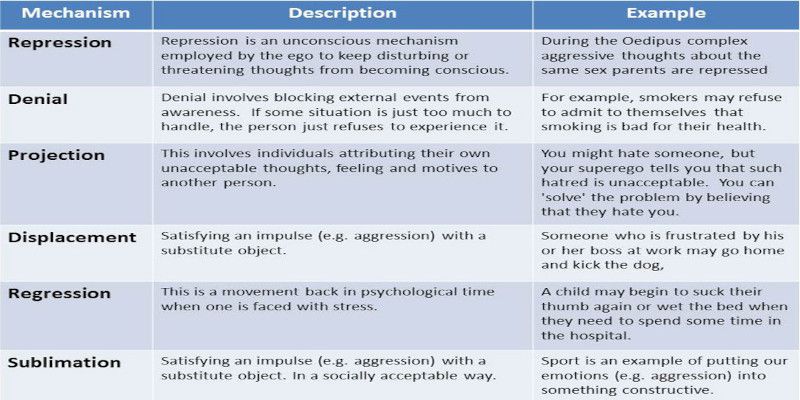Table of Contents
ToggleUnbeknownst to most of us, we frequently utilize one or multiple coping mechanisms in our daily lives for a variety of reasons.
The most important ones are protecting our ego, and reducing stress in addition to anxiety.
The famous neuroscientist Sigmund Freud himself differentiated between 7 defense mechanisms that humans often employ during one’s lifetime to varying degrees.
The 7 defense mechanisms according to Freud

- Regression
- Reaction formation
- Projection
- Rationalization
- Displacement
- Sublimation
- Denial
7 Defense mechanisms explained
Regression
The regression defense mechanism means retreating to a more infantile psychosexual stage where some energy remains fixated. People, especially children, often regress to a previous stage when confronted with a large amount of stress.
For example, a little boy reverts to the comfort of thumb-sucking in the car on the way to school due to experiencing a high amount of stress.
Reaction formation
Reaction formation encompasses switching unacceptable impulses into their opposites, typically to the extreme polar opposite as a result of overcompensation.
For example, when someone represses their angry feelings for a person, they start acting exaggerated friendly, and empathetic.
Projection

Projection is a type of introjection.
Introjection can be described as the procedure of taking in external qualities and integrating them into your ego. These attributes are feelings, ideas, thoughts, and urges.
Disguising one’s own threatening, dark impulses by attributing those feelings and impulses to other people.
An example of projection is a thief who steals from other people and consequently thinks everyone else in the world is also a thief.
Rationalization
Rationalization is also called intellectualization in Freud’s original defense mechanisms.
Offering self-justifying explanations instead of the real, more threatening unconscious reasons for one’s actions. Deliberately rationalizing the situation instead of telling the real truth.
A habitual drinker employing rationalization for example will say they drink with their friends only to be sociable, while in reality, it is because they are addicted.
Displacement

Displacement is also called Reaction formation in Freudian theory.
The displacement defense mechanism stands for shifting aggressive or sexual impulses towards a more acceptable, or weaker, less threatening person or object.
An example of this particular behavior is when a little child kicks the family pet after being sent to their room and, as a result, becomes angry.
Sublimation
Transferring unacceptable impulses into socially accepted and valued motives. These socially accepted motives might differ depending on culture.
For example, a person with aggressive urges becomes a professional fighter or surgeon to use those unacceptable impulses more positively or socially accepted.
Denial
Refusing to believe or even perceive painful realities by denying what one is seeing in an attempt to protect oneself from a painful experience.
An example of denial in real-life practice might look like an individual denying the clear evidence of their cheating partner.
Frequently Asked Questions (FAQ)
What is a defense mechanism?

A defense mechanism can be defined as a specific pattern of behavior to reduce anxiety, and stress protectting our ego.
We often employ those mechanisms in an attempt to reduce anxiety by unconsciously distorting reality. They are regularly enabled due to the repression of emotions.
Repression in turn can be defined as our basic defense mechanism that serves the purpose of banishing anxiety-arousing feelings, thoughts, and memories from our conscious mind.
So in short, coping strategies’ purposes are:
- Protecting the ego
- Reducing anxiety and stress
Origin of defense mechanisms

Defense mechanisms were first described by Sigmund Freud in his psychoanalytic theory.
This theory is a psychological perspective on personality that sees personality as an interaction between three important aspects:
Ego
This is the executive part of our personality and is largely conscious.
According to Freud, the ego mediates among the demands of the superego, ID, and reality.
It operates on the reality principle, aiming to satisfy the ID’s desires so that it will realistically bring pleasure rather than pain.
Superego

The superego, according to Freud, is the part of our personality that represents internalized ideals and thus, provides standards for judgments. (Our conscience) and for future goals.
ID
The id is the most superficial layer and is a reservoir of unconscious psychic energy that aims to satisfy basic sexual and aggressive traits.
It functions on the pleasure principle and demands immediate gratification.
Are the 7 defense mechanisms adaptive?

We speak of an adaptive defense mechanism when a coping strategy leads to a decrease in stress and anxiety. That means that they are all adaptive in some situations.
However, these coping strategies can become maladaptive if they produce more stress and anxiety.
Important to note is that a maladaptive defense mechanism can temporarily lead to a decrease in anxiety and stress, but is not sustainable long-term. Thus, these strategies are immature and incomplete.
An example of an adaptive, mature defense mechanism can be the use of humor to decrease a stressful or threatening situation. Another common example is distraction.
Examples of dysfunctional coping strategies are binge eating, self-harm, and substance abuse.
Defense mechanism example

A possible example of the defense mechanism denial and rationalization in action is the following:
Bob drinks a lot of alcohol. It’s gotten to the point where he drinks during the week, on the weekend, and even at work. This has gotten him into trouble before since he makes mistakes due to being drunk on the job, and regularly oversleeping himself. Yet, Bob says that he has no drinking problem and that oversleeping happens to the best of them.
When he doesn’t drink, he’s shivering from the withdrawal symptoms. He rationalizes his drinking issue by saying that he can function perfectly well while drinking and that it helps him because he’s not shuddering when he’s consuming alcohol.
He denies that he has any issues when his friends and coworkers address him about his behavior and that he can easily quit drinking if he wants to, he just chooses not to.
In this instance, Bob denies that he has an issue with alcohol, that it affects his work performance, that it causes him to oversleep, and even that he suffers from withdrawal-like symptoms when not drinking.
He also rationalizes his behavior by saying he can function perfectly fine, that consuming alcohol helps him with the trembling, and that oversleeping happens to the best of them.
Final take

Defensive mechanisms can be useful and protective in the short term due to limiting how much reality we expose ourselves to at a given time.
Remember, too much painful reality and too many changes (especially those we deem negative) in too short of a period can lead to psychological and even physical problems.
In this light, defensive mechanisms, as the name suggests, have certain protective functions.
However, too many persistent coping strategies might make us oblivious to the truth. It might give us an easy pathway to escape reality and attribute the blame externally instead of to ourselves.




2 thoughts on “7 Defense mechanisms humans often employ”
Comments are closed.